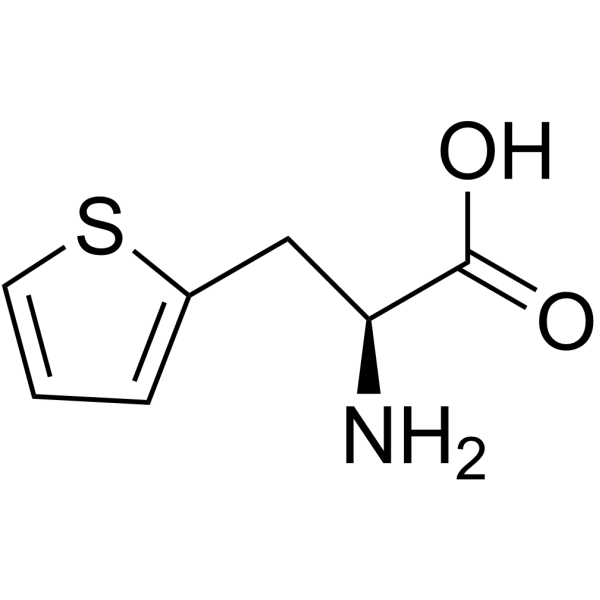3-(2-Thienyl)-L-alanine

3-(2-Thienyl)-L-alanine structure
|
Common Name | 3-(2-Thienyl)-L-alanine | ||
|---|---|---|---|---|
| CAS Number | 22951-96-8 | Molecular Weight | 171.217 | |
| Density | 1.3±0.1 g/cm3 | Boiling Point | 315.9±32.0 °C at 760 mmHg | |
| Molecular Formula | C7H9NO2S | Melting Point | 255-263ºC | |
| MSDS | Chinese USA | Flash Point | 144.9±25.1 °C | |
| Symbol |

GHS07 |
Signal Word | Warning | |
|
Construction of a Bacillus subtilis (natto) with high productivity of vitamin K2 (menaquinone-7) by analog resistance.
Biosci. Biotechnol. Biochem. 65(9) , 2007-15, (2001) To invent a functional natto promoting bone formation, the construction of a strain with high productivity of vitamin K2 (menaquinone-7: MK-7), which is important in the carboxylation of a kind of bone protein participating in bone formation, osteocalcin, was... |
|
|
The developmental biology of heterocyst and akinete formation in cyanobacteria.
Crit. Rev. Microbiol 9(1) , 45-100, (1981) We will be concerned with the two major differentiated cell types of filamentous cyanobacteria--the heterocyst and the akinete. The former is generally accepted to be the site of aerobic nitrogen fixation in heterocystous cyanobacteria. The latter is a spore-... |
|
|
Colonization by Salmonella typhimurium and Shigella flexneri III of the gastrointestinal tract of mice treated with beta-2-thienylalanine and streptomycin.
Antonie van Leeuwenhoek 45(4) , 531-46, (1979) Mice fed beta-2-thienylalanine (beta-2-T) by oesophageal tube were no more susceptible to gastrointestinal tract colonization by Salmonella typhimurium or Shigella flexneri III than control mice fed water. In both beta-2-T-fed and water-fed groups, the increa... |
|
|
Production of amino acids by analog-resistant mutants of the cyanobacterium Spirulina platensis.
J. Bacteriol. 147(3) , 1002-7, (1981) Mutants of Spirulina platensis resistant to 5-fluorotryptophan, beta-3-thienyl-alanine, ethionine, p-fluorophenylalanine, or azetidine-2-carboxylic acid were isolated. Some of these mutants appeared to be resistant to more than one analog and to overproduce t... |
|
|
Uptake and incorporation of amino acids by suspension cultured mammalian cells: a comparative study involving eleven naturally-occurring and four analogue amino acids.
Cytobios. 30(118) , 101-26, (1981)
|
|
|
Transient cell cycle arrest of Saccharomyces cerevisiae by amino acid analog beta-2-DL-thienylalanine.
J. Bacteriol. 141(1) , 100-5, (1980) When treated with the amino acid analog beta-2-DL-thienylalanine, cells of the yeast Saccharomyces cerevisiae accumulated in the G1 portion of the cell cycle at the "start" event. This G1 arrest was accompanied by a rapid decrease in the rate of labeling of r... |
|
|
The assay on a defined medium of the effects of beta-2-thienylalanine on the growth of anaerobic bacterial isolates from phenylketonuric patients.
Med. Microbiol. Immunol. 168(1) , 11-24, (1980) Faecal samples were taken from three diet-managed phenylketonuric children to determine effects of beta-2-thienylalanine (beta-2-t) on indigenous bacteria. From sample swabs, 127 anaerobes were identified and tested for beta-2-t inhibition on a phenylalanine ... |
|
|
Self-assembly of a designed amyloid peptide containing the functional thienylalanine unit.
J. Phys. Chem. B 114(32) , 10674-83, (2010) The self-assembly of a peptide based on a sequence from the amyloid beta peptide but incorporating the non-natural amino acid beta-2-thienylalanine (2-Thi) has been investigated in aqueous and methanol solutions. The peptide AAKLVFF was used as a design motif... |
|
|
An investigation of position 3 in arginine vasopressin with aliphatic, aromatic, conformationally-restricted, polar and charged amino acids.
J. Pept. Sci. 5(3) , 141-53, (1999) We report the solid-phase synthesis and some pharmacological properties of 23 new analogs of arginine vasopressin (AVP) which have the Phe3 residue replaced by a broad variety of amino acids. Peptides 1-9 have at position 3: (1) the mixed aromatic/aliphatic a... |
|
|
Comparison of liquid and agar-solidified defined media regarding the physiological mechanism by which beta-2-thienylalanine inhibits growth of Escherichia, Shigella, and Salmonella cultures.
Microbiol. Immunol. 24(7) , 603-15, (1980) Growth comparisons were made, using Shigella, Escherichia, and Salmonella cultures, in liquid and agar-solidified defined media containing beta-2-thienylalanine (beta-2-t). The comparisons were performed to determine the nature of growth inhibition by beta-2-... |